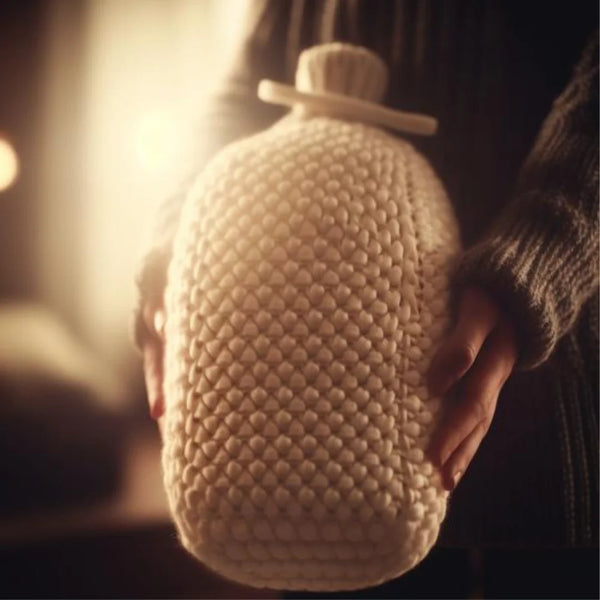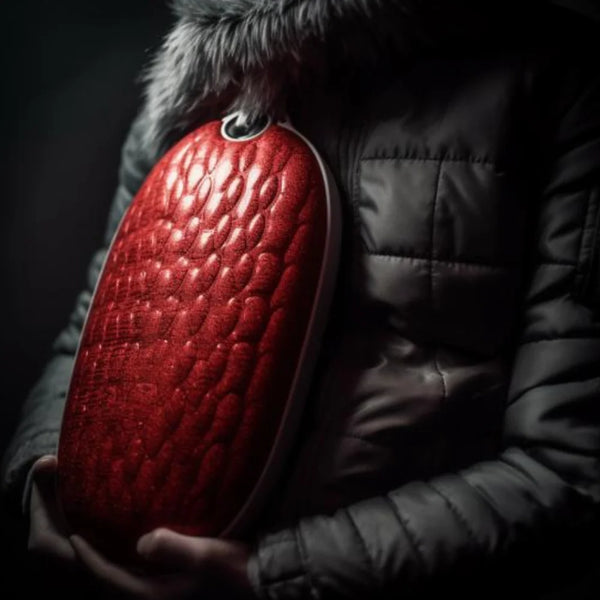Key Takeaways
Using hot water bottles on the stomach carries risks such as burns, but can be safe if you follow precautions for use. It is recommended not to sleep with a hot water bottle, to limit the time of use to 20 minutes maximum and to always place a cloth between the hot water bottle and the skin. Elderly people or those suffering from diabetes must be particularly vigilant.
Introduction
The hot water bottle is a popular accessory providing a localized heat source. Applied to the stomach, it provides appreciable relief in the event of painful periods, bloating or muscle pain.
However, improper use involves dangers that must be understood in order to use this accessory in complete safety. Indeed, the heat released can cause serious burns if the usual precautions are not respected.
This article aims to explain the risks linked to applying a hot water bottle to the stomach and to provide practical advice for enjoying the benefits of heat without danger.
Understanding the dangers of using a hot water bottle on your stomach
Applying a heat source directly to the skin inherently carries risks of burns. The hot water bottle concentrates a large quantity of heat on a specific area of the body.
If the usual precautions are not followed, this heat can quickly cause skin lesions ranging from erythema to second-degree burns.
Importance of safe use
Given the high temperatures generated by a hot water bottle, it is essential to know and rigorously apply the safety instructions in order to avoid any danger.
Inappropriate use of the hot water bottle exposes you to burns which may require medical attention. Effective prevention requires, above all, information.
Overview of potential risks
Depending on the hot water bottle model, different dangers exist: burn, electrocution, fire. The type of hot water bottle used as well as compliance with safety instructions make it possible to effectively prevent these risks.
We will look in more detail at the specific recommendations for each type of hot water bottle.
Also read: What is the best type of hot water bottle ?

Types of hot water bottles and associated risks
There are three main types of hot water bottles, which do not present the same risks:
Water bottle: risk of burns
Water bottles are the most common model. Filled with hot water, they diffuse a humid and constant heat. The main risk is burn. Indeed, if the hot water bottle is too hot or the skin too sensitive, a burn can occur quickly.
Dry hot water bottle: fire danger
Dry hot water bottles contain ceramic grains, which can be heated in a microwave oven. They give off dry heat. If used incorrectly, these hot water bottles present a risk of fire. The outer fabric may catch fire upon prolonged contact with hot grains.
Dry hot water bottles usually contain grains inside, such as bran, wheat, spelt or millet. When these grains are heated, they release dry heat to relieve pain. However, it is essential to ensure that these grains do not leak out of the hot water bottle, otherwise it could cause a fire.
A defect in manufacturing may result in tearing of the fabric. It is therefore recommended to regularly check the condition of the dry hot water bottle and the absence of grains on the outside. Choosing a European or French hot water bottle with strict quality standards helps limit the risk of fire.
Electric hot water bottle: risk of electrocution
Electric hot water bottles incorporate a resistance which heats up when plugging the device into the mains. In addition to the risk of burns, an electrical failure can cause electrocution. Humidity would increase the severity of the electric shock tenfold.
Also read: How does a pocket hot water bottle work ?
Advice for use and precautions
Here are the main practical tips to prevent the risks associated with using a hot water bottle on the stomach:
Recommended duration of use
It is recommended not to use a hot water bottle for more than 20 minutes. Beyond that, heat builds up and increases the risk of burns. It is best to alternate periods of hot and cold.
Precautions to avoid burns
To avoid any direct contact of the skin with the hot water bottle, a cloth should be interposed. Check temperature before application. Do not give a child a hot water bottle that is too hot.
Contraindications and risk situations
The elderly, diabetics and people suffering from circulation or sensitivity disorders should be extra vigilant. Caution is also required when taking hypotensive medications. Do not use while sleeping or in case of extreme fatigue.
Also read: Hot water bottle on the stomach and constipation

Treat risky symptoms before consulting
Before consulting a doctor in the event of worrying symptoms following the use of a hot water bottle, it is recommended to apply the first appropriate care procedures:
In case of burn
- Immediately rinse the burned area with cold water for 10 to 15 minutes to reduce skin temperature.
- Remove clothing unless it is stuck to the skin.
- Cover the burn with a sterile dressing and moisturize the area.
- Watch for blisters, redness and worsening pain.
In case of heat stroke
- Lay the person down and elevate the legs.
- Loosen clothing.
- Refresh the person with a mist of cool water and damp cloths.
- Have fresh water to drink frequently.
- Monitor body temperature.
In the event of electrocution
- Unplug or cut off the power before touching the person.
- Check your breathing and do cardiac massage if necessary.
- Examine burns and treat as a thermal burn.
- Place the person in a side safety position.
- Call emergency services.
These actions make it possible to limit risks before appropriate medical treatment if necessary.
Conclusion
In short, hot water bottles are a pleasant and beneficial source of heat if they are used wisely. Scrupulously respecting the precautions for use allows you to benefit from the benefits of heat in complete safety and to effectively prevent the risks of accidents.
Responsible use combined with quality models and rigorous monitoring of instructions for use are the keys to safe application of the hot water bottle.
| Appearance | Advice | Precautions | Contraindications |
|---|---|---|---|
| Usage | 20 minutes maximum | Interpose a fabric | Elderly people, diabetics |
| Risks | Burns, electrocution, fire | Check temperature | Use while sleeping |
| Types of hot water bottles | Water, dry, electric | Follow the instructions | Traffic problems |
| Benefits | Pain relief | Do not overheat | Taking hypotensive medications |
| Prevention | Choice of quality models | Following instructions for use | Extreme fatigue |
FAQ
Is it good to put a hot water bottle on your stomach ?
Yes, using a hot water bottle on the stomach can relieve certain pains such as periods or cramps. However, it is essential to follow standard precautions to avoid burns and other risks. Pregnant women should consult their doctor before use.
When to put a hot water bottle on your stomach ?
You can put a hot water bottle on the stomach to relieve menstrual, intestinal, muscular or joint pain. The ideal is to use it at the start of symptoms to relax the muscles and promote blood circulation.
Why not sleep with a hot water bottle ?
It is not recommended to sleep with a hot water bottle on the stomach because the constant heat can cause burns serious. The risk of slippage is also increased, hence the importance of removing it before sleeping.
Does a hot water bottle do good to the liver ?
Yes, the heat from a hot water bottle can relax the abdominal muscles and improve blood circulation to the liver. This relieves liver pain. But be careful of burns: it is preferable to use heaters at 37°C.
Where to place your hot water bottle in bed ?
It is recommended to place the hot water bottle on the stomach or lower back in a lying position, interposing a cloth.Near a wall or stuck with a pillow limits the risk of slippage. It must be removed before sleeping.
Sources
- "Hot Water Bottle Burns in Diabetics", National Center for Biotechnology Information
Hot water bottle burns are a common complication of diabetes. Diabetic patients are more likely to suffer from deep burns and infections due to diabetic neuropathy, which causes loss of sensation.
- "Opinion relating to dry hot water bottles", Consumer Safety Commission
The French Consumer Safety Commission (CSC) has received several requests concerning accidents occurring when using hot water bottles. These accidents led to serious burns and even deaths.
The CSC therefore conducted an investigation into the safety of hot water bottles. In particular, it studied the different categories of hot water bottles available on the market, as well as the applicable standards.
The CSC concluded that the use of hot water bottles carries a rare but potential risk of burns. This risk is linked to several factors, including:
- Rupture of the hot water bottle casing, which can be caused by overheating, misuse or manufacturing defect.
- Direct contact of the skin with the hot water bottle, which can be hot.
- Using a hot water bottle for a use other than that for which it is intended, for example to heat food or cosmetic products.
The CSC therefore recommends that consumers take the following precautions when using hot water bottles:
- Follow the manufacturer's instructions for use.
- Do not overheat the hot water bottle.
- Regularly check the condition of the hot water bottle casing.
- Do not use the hot water bottle for any purpose other than that for which it is intended.
Updated March 25, 2024







